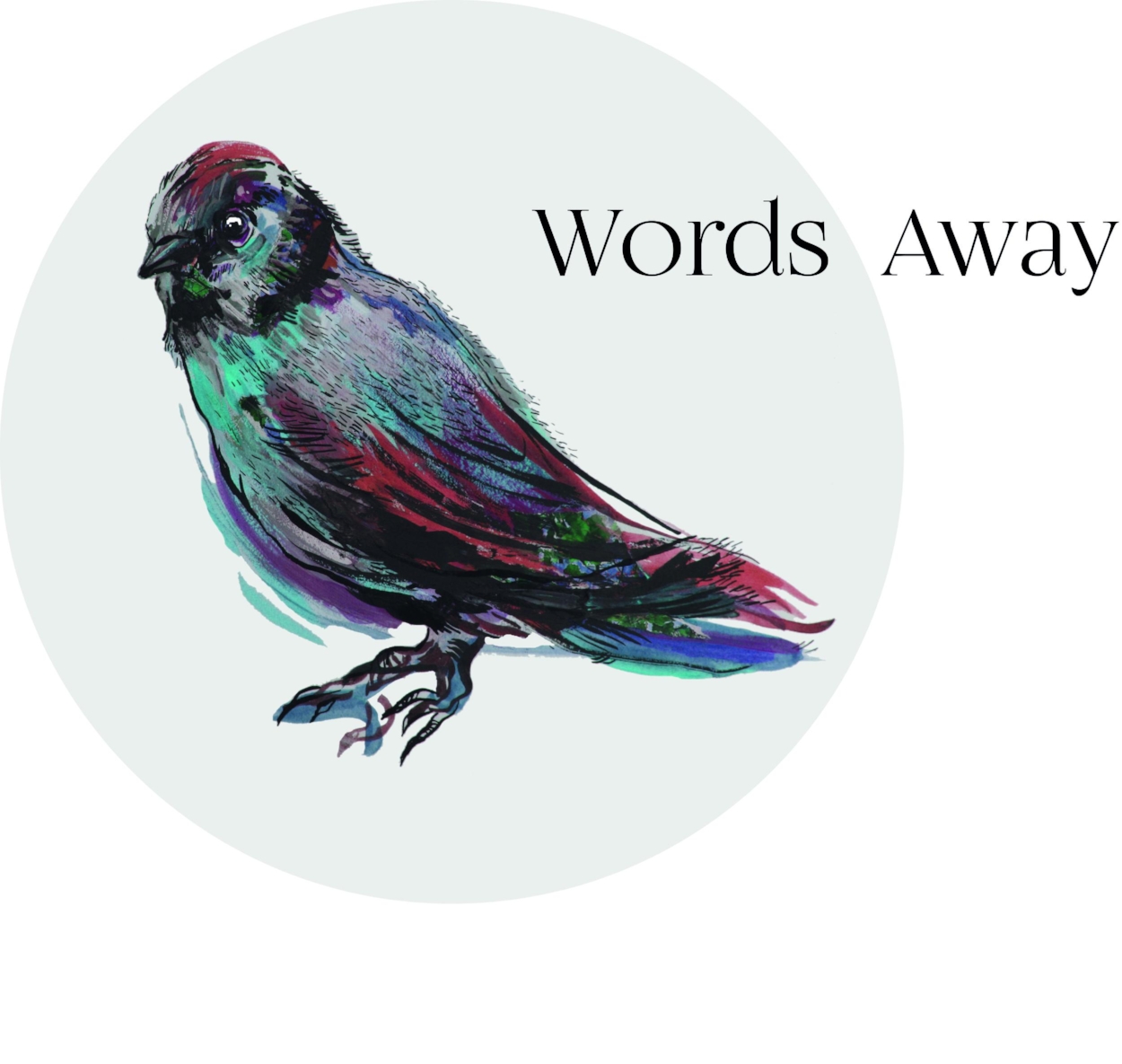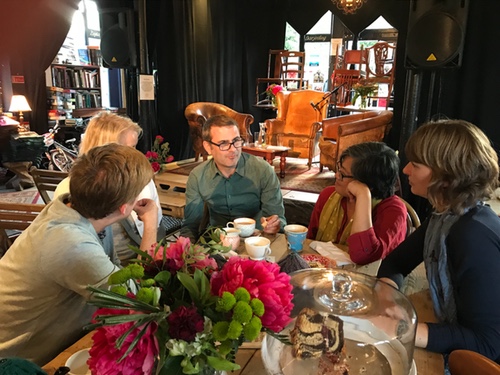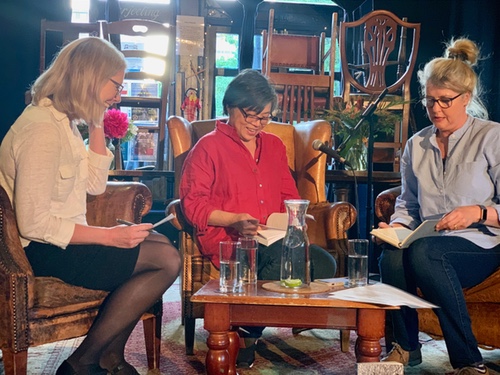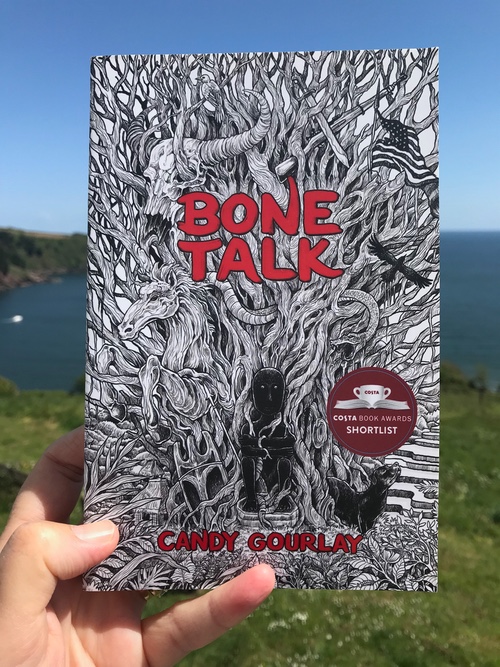We welcomed author Candy Gourlay to Words Away last week for our May salon, Writing for Children. Candy’s been busy travelling the globe, visiting schools, literary festivals and launching her latest novel Bone Talk in the Philippines. We felt very lucky to lure her to the Tea House to talk to us about her writing. We had a fab audience, including a friendly contingent from the Society of Children’s Book Writers and Illustrators, many of whom stayed on for a drink and chat after the discussion.
Chatting before the salon - children’s writers Cath Howe, Lucy Van Smit, Peter Bunzl, Candy Gourlay and Camilla Chester
Candy is a Filipino children's author living in London. Her latest novel Bone Talk, shortlisted for the 2019 Carnegie Medal and the Costa Prize, is set in the Philippines when headhunting people came face to face with the American invading forces in 1899. Her first picture book, Is It a Mermaid, illustrated by Francesca Chessa has been nominated for the Kate Greenaway Medal. Candy is writer in residence for the Booktrust, which is the UK's largest children's reading charity, every year supporting millions of children across the UK with books, resources and support.
Candy said she’s wanted to write for kids ever since childhood. It took her years to fulfil her dream of becoming an author and years to learn that Filipino stories also belong in the pages of a book. She didn’t think she had a chance of becoming a writer so she became a journalist instead. She had many adventures writing politics for Sunday Magazines and travelling around Asia. She lived through a dictatorship, a revolution and somewhere in all this, Candy met her husband. She moved to the UK where she’s lived with her family for the last thirty years.
With Emma Darwin and Candy Gourlay
When Candy began writing for children around ten years ago, she thought she had to write books about white people or she might not get published. Back then few people of colour featured in the literary landscape apart from Malorie Blackman, and so Candy’s first book was set in London and featured white characters. The book was rejected by someone in publishing who told her that she couldn’t write about white children because of where she was from and questioned why she wasn’t writing stories about the Philippines. She realised that she’d written her first novel with a fear of exposing herself. She knew she was holding back and it taught her that it’s not just write what you know, it’s write who you are.
It took a lot of courage but Candy set about trying to find a story that she could pull into a book with a hero from the Philippines. She asked herself what do we have in the Philippines that’s unique? We are the land of disaster, she said, with earthquakes, floods and all the things we read about in the bible. She decided to have an earthquake at the centre of the story. In the Philippines whenever people talk about earthquakes they talk about giants.. When she was a kid, her father would tell her stories saying, don’t be scared it’s just the giants fighting again. Candy’s first novel Tall Story is about a boy who becomes a giant. The whole story evolved from a desire to put the Philippines at the heart of the book.
Candy’s approach to writing is a combination of feeling and planning. She tries to write a few chapters, maybe three or four, to see if it feels like it can grow into a book. If it feels like a book she’ll go ahead and plan. She started Tall Story with the words “So many armpits, so little deodorant…” which has remained the opening scene of the book. It’s about hearing the voice and finding something alive.
She set about writing Bone Talk with a political agenda. Candy really wanted to write book about colonialism, about a particular time and place in Philippine history, because so many people do not know that the country was invaded by the United States in 1899. Back then Manilla was culturally very like Cuba, with bullfighting, operas, orchestras and novel-writers, while just outside the city lived many different tribes. Candy wanted to capture that moment in her history and write about one particular headhunting tribe. She loves books set in historical settings but they are always about other people’s histories. There was nothing written about that time from a Filipino point of view - there’s only the accounts, letters and diaries of the invaders and elites. Candy talked about the impact of colonisation on the identity of the indigenous population saying, “That’s how colonisers work. They came, they conquered, and the headhunters became ashamed of who they were.” This pervading sense of shame made research difficult. Candy travelled to where Bone Talk is set and tried talking to the local people about what it was like in headhunting times. 1899 is not that long ago for memories to be lost, but no one wanted to talk about it because they were ashamed of their past.
Bone Talk evolved from an idea for a story inspired by the 1904 St Louis World Fair where nine tribes from the Philippines were exhibited like animals in a human zoo. Candy realised after researching and outlining the story that she couldn’t do it without being offensive to the tribes she was writing about. Without any context the reader would be looking down and judging the tribes in the same way the people of St Louis once did. By transporting all these people to St Louis without any context of who they were it was very hard to look at this culture and not be freaked out by the animal sacrifice and the way they dressed. She didn’t have time in the limited space of a children’s novel to build her characters, and their world, in a sympathetic way. She decided to write about the time before the World Fair so that the context was clear - settling on the point when the United States invades the Philippines. Ultimately Bone Talk is not so much about American colonialism but more about a boy whose life changes. He knew who he was until the arrival of the Americans when everything was disrupted and turned around. Now that the story has context, Candy’s working on the sequel to Bone Talk and revisiting the St Louis world again.
Candy talked about giving herself permission to write the story of a marginalised people. She admitted it was a scary story to write and it worried her because, although she is Filipino she doesn’t belong to this particular tribe. Her aim was to tell the story of a marginalised people at the point of change, so that the reader can think about the effect this has had. It’s worth reading the acknowledgement letter at the end of Bone Talk to see Candy’s considered approach to the story. Amnesty International endorses the novel for holding up many fundamental human rights and for showing us what can happen when these rights are taken away.
May bank holiday reading
Candy researched Bone Talk extensively, asking questions about language, belief systems and cultural practices. It was vital to know and understand what her characters believed in. For example she asked, how would they talk? She didn’t speak their language. So she read the diaries & accounts of explorers but this was problematic - the sources were not reliable. In the end it was the letters of a house-wife who lived amongst the tribes people that were most helpful. This woman wrote about everyday things including how little local boys would visit to borrow reading books. The children in the letters sounded like ordinary little boys, mischievous, cute. Candy added little flourishes, like ‘weh’ and ‘agh’ to add character. The character’s voices came from writing - they didn’t come from research. The more she wrote them, the more real they became. When the voice popped out she went back to the beginning and put life into the characters that were still wooden.
We talked about her approach to sensitive subjects like circumcision, beheading and violet death. Candy said the interesting challenge when she writes a world that’s not been written about is finding a way to make it accessible to the child reader. She makes most of the horror take place in the distance or off stage. It was important to represent the culture she was writing about without being squeamish. These people, she said, have been seen as ‘primitive’ and subject to racism - it’s important to get it right so when somebody’s reading the book they don’t look down on them. You make a promise at the beginning of the book so that the reader knows what’s in store. The reader can choose to put the book down or continue reading. Candy’s books offer an emotional experience that children can empathise with.The greatest challenge for a children’s writer is that your reader doesn’t have patience; if you keep explaining you’ll lose them. You have to sew your research into hidden places so that the reader is learning something that helps with the story later. You have to be really manipulative about your how your readers acquire knowledge!
Candy’s written three very different novels that appeal to three different young audiences and tastes. She writes for the independent publisher, David Fickling, who supports her work and encourages her to write what ever she wants to write. Candy said this is unusual as the received industry advice is if you’re writing children books stay within your world because your reader grows so fast. This made things difficult at the beginning of her career because with each book she had to rebuild her readerships and relationships with teachers and librarians.
Emma and Candy
I’ve featured just some of the highlights of our chat with Candy and hope it gives you a taste of what was an excellent discussion. With big thanks to Candy and Emma and everyone who came along. Our next salon at the Tea House Theatre is on Tuesday 18th June (note: not on our usual Monday night!) when we’re looking forward to talking Voice: The Writer’s Palette with Kelleigh Greenberg-Jephcott. Kelleigh’s novel Swan Song is now out in paperback and was recently long-listed for The Women’s Prize! We also have a few spaces available, if you’re quick, for The Craft of Revising: A Masterclass on Self-editing for Writers led by Andrew Wille on Saturday June 15th at the London Bridge Hive. The day will also include a Q&A on the working life of an editor with Faiza S Khan of Bloomsbury Publishing. Our last salon before the summer break is on Monday, July 8th: Miracle in a Matchbox: the Art of Short Story Writing with guest writer: Adam Marek.
Hope to see you soon!
Kellie
References & Links
Candy Gourlay, Society of Children's Book Writers and Illustrators, Tom Sawyer, Roald Dahl, The Cogheart Adventures by Peter Bunzl, Cath Howe, David Fickling Books, Historia Magazine: Dr Darwin’s Writing Tips: How do I convey necessary information without it being clunkingly obvious, Previous salons where we’ve discussed issues around cultural appropriation: Recovering Voices and Stories Lost From History with Alice Jolly & The Power of Place with Courttia Newland, The Hero’s Journey, The Wake by Paul Kingsworth, The Lie Tree by Frances Hardinge, Melvin Burgess, Growing up I thought Filipinos weren't allowed to be in books: Candy Gourlay for The Guardian, Leila Rasheed, Mallorie Blackman, Jacqueline Wilson, Verna Wilkins & Tamarind Books
A little writing time before the salon begins






